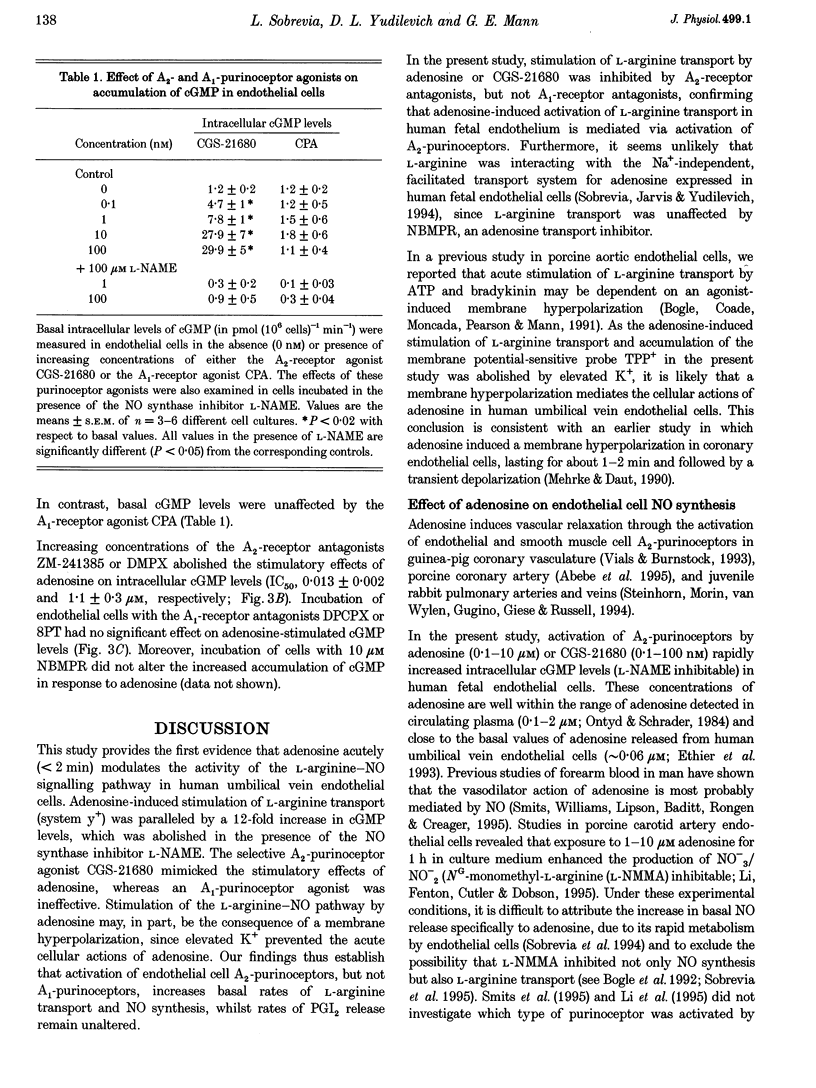Abstract
1. Human umbilical vein endothelial cells were challenged acutely with adenosine and its analogues to examine whether adenosine modulates L-arginine transport (system y+) and synthesis of nitric oxide (NO) and prostacyclin (PGI2). 2. L-Arginine transport was stimulated by adenosine (10 microM, 2 min) and the A2-receptor agonist 2-p-(2-carboxyethyl)phenethylamino-5'-N-ethylcarboxamidoadenosine (CGS-21680; 100 nM), but not by the A1-receptor agonist N6-cyclopentyladenosine (CPA). 3. Activation of L-arginine transport was inhibited by the A2-receptor antagonists ZM-241385 and 3,7-dimethyl-1-propargylxanthine (DMPX), but unaffected by the A1-receptor antagonists 8-cyclopentyl-1,3-dipropylxanthine and 8-phenyltheophylline or the adenosine transport inhibitor nitrobenzylthioinosine. 4. Adenosine and CGS-21680 evoked a rapid membrane hyperpolarization. 5. Adenosine and CGS-21680 induced increases in intracellular cGMP levels, whereas release of PGI2 was unaffected. NG-nitro-L-arginine methyl ester (an NO synthase inhibitor) and the A2-receptor antagonists ZM-241385 and DMPX prevented increases in cGMP accumulation. 6. Our findings provide the first evidence that activation of human fetal endothelial cell A2-purinoceptors, but not A1-purinoceptors, leads to a membrane hyperpolarization and stimulation of basal rates of L-arginine transport and NO biosynthesis.
Full text
PDF





Selected References
These references are in PubMed. This may not be the complete list of references from this article.
- Angello D. A., Berne R. M., Coddington N. M. Adenosine and insulin mediate glucose uptake in normoxic rat hearts by different mechanisms. Am J Physiol. 1993 Sep;265(3 Pt 2):H880–H885. doi: 10.1152/ajpheart.1993.265.3.H880. [DOI] [PubMed] [Google Scholar]
- Ayajiki K., Kindermann M., Hecker M., Fleming I., Busse R. Intracellular pH and tyrosine phosphorylation but not calcium determine shear stress-induced nitric oxide production in native endothelial cells. Circ Res. 1996 May;78(5):750–758. doi: 10.1161/01.res.78.5.750. [DOI] [PubMed] [Google Scholar]
- Bogle R. G., Coade S. B., Moncada S., Pearson J. D., Mann G. E. Bradykinin and ATP stimulate L-arginine uptake and nitric oxide release in vascular endothelial cells. Biochem Biophys Res Commun. 1991 Oct 31;180(2):926–932. doi: 10.1016/s0006-291x(05)81154-4. [DOI] [PubMed] [Google Scholar]
- Bogle R. G., Moncada S., Pearson J. D., Mann G. E. Identification of inhibitors of nitric oxide synthase that do not interact with the endothelial cell L-arginine transporter. Br J Pharmacol. 1992 Apr;105(4):768–770. doi: 10.1111/j.1476-5381.1992.tb09053.x. [DOI] [PMC free article] [PubMed] [Google Scholar]
- Challiss R. A., Richards S. J., Budohoski L. Characterization of the adenosine receptor modulating insulin action in rat skeletal muscle. Eur J Pharmacol. 1992 Jun 5;226(2):121–128. doi: 10.1016/0922-4106(92)90172-r. [DOI] [PubMed] [Google Scholar]
- Ethier M. F., Chander V., Dobson J. G., Jr Adenosine stimulates proliferation of human endothelial cells in culture. Am J Physiol. 1993 Jul;265(1 Pt 2):H131–H138. doi: 10.1152/ajpheart.1993.265.1.H131. [DOI] [PubMed] [Google Scholar]
- Law W. R., Raymond R. M. Adenosine potentiates insulin-stimulated myocardial glucose uptake in vivo. Am J Physiol. 1988 May;254(5 Pt 2):H970–H975. doi: 10.1152/ajpheart.1988.254.5.H970. [DOI] [PubMed] [Google Scholar]
- Li J. M., Fenton R. A., Cutler B. S., Dobson J. G., Jr Adenosine enhances nitric oxide production by vascular endothelial cells. Am J Physiol. 1995 Aug;269(2 Pt 1):C519–C523. doi: 10.1152/ajpcell.1995.269.2.C519. [DOI] [PubMed] [Google Scholar]
- Mehrke G., Daut J. The electrical response of cultured guinea-pig coronary endothelial cells to endothelium-dependent vasodilators. J Physiol. 1990 Nov;430:251–272. doi: 10.1113/jphysiol.1990.sp018290. [DOI] [PMC free article] [PubMed] [Google Scholar]
- Olsson R. A., Pearson J. D. Cardiovascular purinoceptors. Physiol Rev. 1990 Jul;70(3):761–845. doi: 10.1152/physrev.1990.70.3.761. [DOI] [PubMed] [Google Scholar]
- Ontyd J., Schrader J. Measurement of adenosine, inosine, and hypoxanthine in human plasma. J Chromatogr. 1984 May 11;307(2):404–409. doi: 10.1016/s0378-4347(00)84113-4. [DOI] [PubMed] [Google Scholar]
- Read M. A., Boura A. L., Walters W. A. Vascular actions of purines in the foetal circulation of the human placenta. Br J Pharmacol. 1993 Sep;110(1):454–460. doi: 10.1111/j.1476-5381.1993.tb13832.x. [DOI] [PMC free article] [PubMed] [Google Scholar]
- Skinner M. R., Marshall J. M. Studies on the roles of ATP, adenosine and nitric oxide in mediating muscle vasodilatation induced in the rat by acute systemic hypoxia. J Physiol. 1996 Sep 1;495(Pt 2):553–560. doi: 10.1113/jphysiol.1996.sp021615. [DOI] [PMC free article] [PubMed] [Google Scholar]
- Smits P., Williams S. B., Lipson D. E., Banitt P., Rongen G. A., Creager M. A. Endothelial release of nitric oxide contributes to the vasodilator effect of adenosine in humans. Circulation. 1995 Oct 15;92(8):2135–2141. doi: 10.1161/01.cir.92.8.2135. [DOI] [PubMed] [Google Scholar]
- Sobrevia L., Cesare P., Yudilevich D. L., Mann G. E. Diabetes-induced activation of system y+ and nitric oxide synthase in human endothelial cells: association with membrane hyperpolarization. J Physiol. 1995 Nov 15;489(Pt 1):183–192. doi: 10.1113/jphysiol.1995.sp021040. [DOI] [PMC free article] [PubMed] [Google Scholar]
- Sobrevia L., Nadal A., Yudilevich D. L., Mann G. E. Activation of L-arginine transport (system y+) and nitric oxide synthase by elevated glucose and insulin in human endothelial cells. J Physiol. 1996 Feb 1;490(Pt 3):775–781. doi: 10.1113/jphysiol.1996.sp021185. [DOI] [PMC free article] [PubMed] [Google Scholar]
- Sobrevía L., Jarvis S. M., Yudilevich D. L. Adenosine transport in cultured human umbilical vein endothelial cells is reduced in diabetes. Am J Physiol. 1994 Jul;267(1 Pt 1):C39–C47. doi: 10.1152/ajpcell.1994.267.1.C39. [DOI] [PubMed] [Google Scholar]
- Steinhorn R. H., Morin F. C., 3rd, Van Wylen D. G., Gugino S. F., Giese E. C., Russell J. A. Endothelium-dependent relaxations to adenosine in juvenile rabbit pulmonary arteries and veins. Am J Physiol. 1994 May;266(5 Pt 2):H2001–H2006. doi: 10.1152/ajpheart.1994.266.5.H2001. [DOI] [PubMed] [Google Scholar]
- Vials A., Burnstock G. A2-purinoceptor-mediated relaxation in the guinea-pig coronary vasculature: a role for nitric oxide. Br J Pharmacol. 1993 Jun;109(2):424–429. doi: 10.1111/j.1476-5381.1993.tb13586.x. [DOI] [PMC free article] [PubMed] [Google Scholar]


